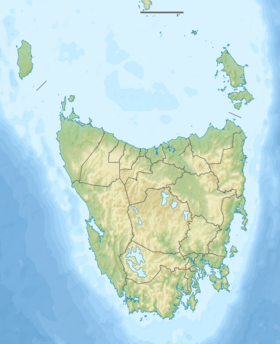Point Hibbs
| Point Hibbs | |
| Headland | |
| Country | Australia |
|---|---|
| State | Tasmania |
| Region | South West |
| Location | South West Tasmania |
| - coordinates | 42°36′36″S 145°15′36″E / 42.61000°S 145.26000°ECoordinates: 42°36′36″S 145°15′36″E / 42.61000°S 145.26000°E |
| UNESCO World Heritage Site | |
| Name | Tasmanian Wilderness |
| Year | 1982 (#6) |
| Number | 181 |
| Region | Oceania |
| Criteria | Mixed |
| National park | Southwest NP |
 Location of Point Hibbs in Tasmania | |
Point Hibbs is a headland on the south-west coast of Tasmania, Australia. The headland is located south of the most southern point of Macquarie Harbour, and west of the Gordon River. It is the next named feature along the coast south of Cape Sorell that is used to delineate sections of the coast.[1][2] Like South West Cape, it is used as a reference point for nearby wrecks.[3]
It is on the north side of the point, that the Hibbs Pyramid rock, and the Hibbs Lagoon lie. The lagoon is a recommended seaplane landing location, and the beach a helicopter landing location and supply-drop area for walkers on the coastline.[4] The Hibbs River enters the bay at the north end, flowing into the lagoon. The lagoon is less than 20 kilometres (12 mi) from Birchs Inlet.
The point has also been a location of sightings of unusual sea animals[5] and whale strandings.[6]
The south side of the headland on which Point Hibbs occurs, has Spero Bay, and the mouth of the Spero River. The south side of the bay is lined by a small rocky headland with Lowren Hill of 116m behind it. The next bay south is Endeavour Bay.
The Spero River was a location of timber milling in the 1930s [7][8][9]
The geology of the area has sparked interest for over a hundred years, but no known mining activity has been sustained in the area.[10]
See also
References
- ↑ Hills, Loftus (1914) Geological reconnaissance of the country between Cape Sorell and Point Hibbs. Hobart : John Vail, Govt. Printer, 1914. Geological Survey bulletin (Tasmania. Geological Survey) ; no. 18.
- ↑ For a letter by Thomas Bather Moore regarding the naming of the features of the coastline and Hibbs River see - "PORT DAVEY TO MACQUARIE HARBOUR.". The Mercury (Hobart, Tas. : 1860-1954). Hobart, Tas.: National Library of Australia. 13 August 1898. p. 3. Retrieved 11 July 2011.
- ↑ "WRECK OF THE BARQUE VARNA, FROM GREENOCK TO MELBOURNE, NEAR POINT HIBBS, TASMANIA.". Bathurst Free Press and Mining Journal (NSW : 1851-1904). NSW: National Library of Australia. 20 February 1858. p. 4. Retrieved 11 July 2011.
- ↑ Chapman, John (2008). South West Tasmania. 5th ed. p. 182. ISBN 978-1-920995-03-4
- ↑ "MYSTERIOUS SEA ANIMAL.". Western Mail (Perth, WA : 1885-1954). Perth, WA: National Library of Australia. 16 January 1914. p. 42. Retrieved 11 July 2011.
- ↑ "More than 100 dead whales found on remote Tasmanian beach". The America's Intelligence Wire. 25 November 2003.
- ↑ "West Coast News and Views". The Advocate (Australia). Tasmania, Australia. 2 December 1936. p. 8. Retrieved 23 November 2016 – via National Library of Australia.
- ↑ "BIG SPERO RIVER TIMBER AREA TO BE WORKED.". The Advocate (Australia). Tasmania, Australia. 13 July 1936. p. 8. Retrieved 23 November 2016 – via National Library of Australia.
- ↑ "FORESTS OF HUON PINE". The Mercury. CXLVI, (20,723). Tasmania, Australia. 1 April 1937. p. 4. Retrieved 23 November 2016 – via National Library of Australia.
- ↑ Waller, George A & Tasmania. Dept. of Mines (1902). In Report on some discoveries of copper ore in the vicinity of Point Hibbs. Dept. of Mines, Hobart